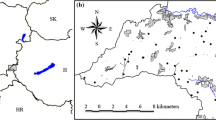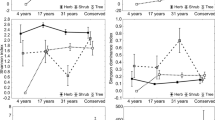Abstract
The conversion of old-growth into secondary forest changes profoundly the community structure of most plant life-forms, including the communities of terrestrial herbs. Here, we verify how herb communities are affected by environmental variables of old-growth and secondary stands of South Brazilian Atlantic Forest. We identified all herbaceous species and estimated their frequency and cover in 16 plots of 6 × 6 m in each forest type. We used the structural characteristics of the tree component (i.e., basal area, density, average height and canopy openness) and soil parameters as environmental variables of each forest. Results showed that old-growth and secondary forests have distinct herb composition, with the later showing higher plant cover and species diversity. Canopy openness and soil parameters explained part of the variation in herb composition between forests. Herb cover and richness responded positively to soil fertility in both forests, and in secondary forest these two descriptors were also positively correlated with canopy openness. The abiotic differences between forests allowed the establishment of herbaceous species with different ecological requirements, especially in the secondary forest, marked by input of species typically found in disturbed environments. These species contribute to the higher cover values and species richness in secondary forest. Our findings suggest that changes in environmental conditions in a forest substantially change the herb community. Because of their importance as environmental indicators, herb communities can contribute to a better understanding of successional patterns in the Atlantic Forest.



Similar content being viewed by others
References
Anderson MJ (2001) A new method for non-parametric multivariate analysis of variance. Austral Ecol 26:32–46
Apg IV (2016) An update of the Angiosperm Phylogeny Group classification for the orders and families of flowering plants: APG IV. Bot J Linn Soc 181:1–20
Behera SK, Misra MK (2006) Floristic and structure of the herbaceous vegetation of four recovering forest stands in the Eastern Ghats of India. Biodivers Conserv 15:2263–2285
Benítez-Malvido J (2006) Effect of low vegetation on the recruitment of plants in successional habitat types. Biotropica 38:171–182
Both S, Fang T, Böhnke M et al (2011) Lack of tree layer control on herb layer characteristics in a subtropical forest, China. J Veg Sci 22:1120–1131
Capers RS, Chazdon RL, Brenes AR, Alvarado BV (2005) Successional dynamics of woody seedling communities in wet tropical secondary forests. J Ecol 93:1071–1084
Causton DR (1988) An introduction to vegetation analysis: principles and interpretation. Unwin Hyman, London
Cestaro LA, Waechter JL, Baptista LRM (1986) Fitossociologia do estrato herbáceo da mata de Araucária da Estação Ecológica de Aracuri, Esmeralda, RS. Hoehnea 13:59–72
Cheung KC, Marques MCM, Liebsch D (2009) Relação entre a presença de vegetação herbácea e a regeneração natural de espécies lenhosas em pastagens abandonadas na Floresta Ombrófila Densa do Sul do Brasil. Acta Bot Bras 23:1048–1056
Citadini-Zanette V (1984) Composição florística e fitossociologia da vegetação herbácea terrícola de uma mata de Torres, Rio Grande do Sul, Brasil. Iheringia Ser Bot 32:23–62
Clark DB (1996) Abolishing virginity. J Trop Ecol 12:735–739
Costa FRC, Magnusson WE (2002) Selective logging effects on abundance, diversity, and composition of tropical understory herbs. Ecol Appl 12:807–819
Costa FRC, Magnusson WE, Luizão AC (2005) Mesoscale distribution patterns of Amazonian understorey herbs in relation to topography, soil and watersheds. J Ecol 93:863–878
De Cáceres M, Jansen F (2013) Indicspecies: Studying the statistical relationship between species and groups of sites. R package version 1.7.1. http://cran.r-project.org/web/packages/indicspecies/. Accessed 22 Sept 2014
De Cáceres M, Legendre P (2009) Associations between species and groups of sites: indices and statistical inference. Ecology 90:3566–3574
Denslow JS, Guzman SG (2000) Variation in stand structure, light, and seedling abundance across a tropical moist forest chronosequence, Panama. J Veg Sci 11:201–212
DeWalt SJ, Maliakal SK, Denslow JS (2003) Changes in vegetation structure and composition along a tropical forest chronosequence: implications for wildlife. For Ecol Manag 182:139–151
Díaz S, Hodgson JG, Thompson K, Cabido M, Cornelissen JHC, Jalili A (2004) The plant traits the drive ecosystems: evidence from three continents. J Veg Sci 15:295–304
EMBRAPA (Empresa Brasileira de Pesquisa Agropecuária) (2009) Sistema brasileiro de classificação de solos. Serviço de Produção de Informação, Rio de Janeiro
FATMA (Fundação Estadual do Meio Ambiente de Santa Catarina) (2010) Plano de manejo do Parque Estadual da Serra Furada—Relatórios temáticos: Meio Físico. Flora e Vegetação. Socioambiental Consultores Associados Ltda, Florianópolis
Frazer GW, Canham CD, Lertzman KP (1999) Gap Light Analyzer (GLA): imaging software to extract canopy structure and gap light transmission indices from true-color fisheye photographs, users manual and program documentation. Simon Fraser University, Burnaby, British Columbia and the Institute of Ecosystem Studies, Millbrook, New York
Gentry AH, Dodson C (1987) Contribution of non-trees to species richness of a tropical rain forest. Biotropica 19:149–156
Gilliam FS (2007) The ecological significance of the herbaceous layer in temperate forest ecosystems. Bioscience 57:845–858
Gotelli NJ, Colwell RK (2001) Quantifying biodiversity: procedures and pitfalls in the measurement and comparison of species richness. Ecol Lett 4:379–391
Griffiths ME, Lawes MJ, Tsvuura Z (2007) Understorey gaps influence regeneration dynamics in subtropical coastal dune forest. Plant Ecol 189:227–236
Guariguata MR, Ostertag R (2001) Neotropical secondary forest succession: changes in structural and functional characteristics. For Ecol Manag 148:185–206
Hammer Ø, Harper DAT, Ryan PD (2001) PAST: paleontological statistics software package for education and data analysis. Palaeontol Electron 4:1–9
Harms KE, Powers JS, Montgomery RA (2004) Variation in small sapling density, understory cover, and resource availability in four neotropical forests. Biotropica 36:40–51
Holdridge LR, Grenke WC, Hatheway WH, Liang T, Tosi JA (1971) Forest environments in tropical life zones: a pilot study. Pergamon Press, Oxford
IBGE (2012) Manual Técnico da Vegetação Brasileira. Manuais Técnicos em Geociências, 1, 2nd edn. Instituto Brasileiro de Geografia e Estatística (IBGE), Rio de Janeiro
Jones MM, Cicuzza D, van Straaten O, Veldkamp E, Kessler M (2014) Determinants of fern and angiosperm herb community structure in lower montane rainforest in Indonesia. J Veg Sci 25:1216–1224
Jules MJ, Sawyer JO, Jules ES (2008) Assessing the relationships between stand development and understory vegetation using a 420-year chronosequence. For Ecol Manag 255:2384–2393
Klein RM (1980) Ecologia da flora e vegetação do vale do Itajaí. Sellowia 32:165–389
Kozera C, Rodrigues RR, Dittrich VAO (2009) Composição florística do sub-bosque de uma Floresta Ombrófila Densa Montana, Morretes, PR, Brasil. Floresta 39:323–334
Laska MS (1997) Structure of understory shrub assemblages in adjacent secondary and old growth tropical wet forests, Costa Rica. Biotropica 29:29–37
Liebsch D, Acra LA (2004) Riqueza de espécies de sub-bosque de um fragmento de Floresta Ombrófila Mista em Tijucas do Sul, PR. Cienc Florest 14:67–76
Manninen OH, Stark S, Kytöviita M-M et al (2009) Understorey plant and soil responses to disturbance and increased nitrogen in boreal forests. J Veg Sci 20:311–322
Maraschin-Silva F, Scherer A, Baptista LRM (2009) Diversidade e estrutura do componente herbáceo-subarbustivo em vegetação secundária de Floresta Atlântica no sul do Brasil. Rev Bras Biociênc 7:53–65
McArdle BH, Anderson MJ (2001) Fitting multivariate models to community data: a comment on distance-based redundancy analysis. Ecology 82:290–297
Moora M, Daniell T, Kalle H et al (2007) Spatial pattern and species richness of boreonemoral forest understorey and its determinants—a comparison of differently managed forests. For Ecol Manag 250:64–70
Mueller-Dombois D, Ellenberg H (1974) Aims and methods of vegetation ecology. Wiley, New York
Müller SC, Waechter JL (2001) Estrutura sinusial dos componentes herbáceo e arbustivo de uma floresta costeira subtropical. Rev Bras Bot 24:395–406
Nimer E (1979) Climatologia do Brasil. IBGE-SUPREN, Rio de Janeiro
Oksanen J, Blanchet FG, Kindt R et al (2013) vegan: community ecology package. R package version 2.0-10. http://CRAN.R-project.org/package=vegan. Accessed 14 April 2014
Oliveira-Filho AT, Fontes MAL (2000) Patterns of floristic differentiation among atlantics forests in southeastern Brazil and the influence of climate. Biotropica 32:793–810
Paciencia MLB, Prado J (2005) Effects of forest fragmentation on pteridophyte diversity in a tropical rain forest in Brazil. Plant Ecol 180:87–104
Poulsen AD, Balslev H (1991) Abundance and cover of ground herbs in an Amazonian rain forest. J Veg Sci 2:315–322
R Core Team (2015) R: A language and environment for statistical computing. R Foundation for Statistical Computing. http://www.R-project.org/. Accessed 02 Mar 2015
Ribeiro MC, Metzger JP, Martensen AC, Ponzoni FJ, Hirota MM (2009) The Brazilian Atlantic Forest: how much is left, and how is the remaining forest distributed? Implications for conservation. Biol Conserv 142:1144–1156
Ronquim CC (2010) Conceitos de fertilidade do solo e manejo adequado para as regiões tropicais. EMBRAPA, Campinas
Sevegnani L, Gasper AL, Bonnet A et al (2013a) Flora Vascular da Floresta Ombrófila Densa em Santa Catarina. In: Vibrans AC, Sevegnani L, Gasper AL, Lingner DV (eds) Inventário Florístico Florestal de Santa Catarina, vol 4. Edifurb, Blumenau, pp 127–139
Sevegnani L, Uhlmann A, Gasper AL et al (2013b) Estádios sucessionais na Floresta Ombrófila Densa em Santa Catarina. In: Vibrans AC, Sevegnani L, Gasper AL, Lingner DV (eds) Inventário Florístico Florestal de Santa Catarina, vol 4. Edifurb, Blumenau, pp 311–322
Smith AR, Pryer KM, Shuettpelz E, Korall P, Schneider H, Wolf PG (2008) Fern classification. In: Ranker TA, Haufker CH (eds) Biology and evolution of ferns and lycophytes. Cambridge University Press, Cambridge, pp 417–467
Tóthmérész B (1995) Comparison of different methods for diversity ordering. J Veg Sci 6:283–290
Turner II, Tan HTW, Chua KS (1996) Relationships between herb layer and canopy composition in a tropical rain forest successional mosaic in Singapore. J Trop Ecol 12:843–851
Van Andel T (2001) Floristic composition and diversity of mixed primary and secondary forests in northwest Guyana. Biodivers Conserv 10:1645–1682
Veloso HP, Klein RM (1957) As comunidades vegetais e associações vegetais da mata pluvial do sul do Brasil. 1: as comunidades do município de Brusque, Estado de Santa Catarina. Sellowia 8:81–235
Vieira LTA, Polisel RT, Ivanauskas NM, Shepherd GJ, Waechter JL, Yamamoto K, Martins FR (2015) Geographical patterns of terrestrial herbs: a new component in planning the conservation of the Brazilian Atlantic Forest. Biodivers Conserv 24:2181–2198
Werner P (1984) Changes in soil properties during tropical wet forest succession in Costa Rica. Biotropica 16:43–50
Acknowledgements
We thank the team of Plant Ecology and Plant Geography Lab of the Federal University of Rio Grande do Sul (UFRGS) for many useful comments. We are grateful to Fábio H. Llanos, João A. B. Vitto, Vander J. Bertoldo Filho and Vanessa Bernardo for field support and assistance and Michelle H. Nervo, Rosana M. Senna, Pedro J. S. Silva Filho, Ilsi I. Boldrini, Eduardo Pasini and Frediny B. Colla for helping in species identification. We also thank Santa Catarina Environmental Foundation (FATMA) for authorizing our access to the Serra Furada State Park, and Foundation to Support Research and Innovation of Santa Catarina (FAPESC) and Brazilian Research Council (CNPq) for financial support, the later for a grant to the first author during the study.
Author information
Authors and Affiliations
Corresponding author
Rights and permissions
About this article
Cite this article
dos Santos-Junior, R., Citadini-Zanette, V., dos Santos, R. et al. Composition and diversity patterns of terrestrial herb communities in old-growth and secondary South Brazilian Atlantic Forest. Braz. J. Bot 40, 951–961 (2017). https://doi.org/10.1007/s40415-017-0411-2
Received:
Accepted:
Published:
Issue Date:
DOI: https://doi.org/10.1007/s40415-017-0411-2




